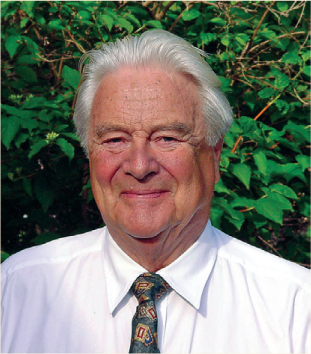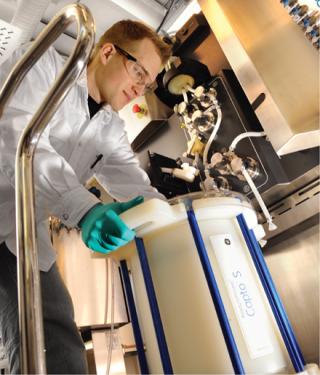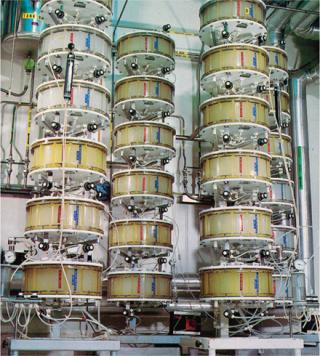It has been 50 years since the first Sephadex paper was published (1). Readers of BioProcess International work in a field that was fundamentally affected by what happened after that paper appeared in 1959. So this anniversary is certainly worthy of a party and a few speeches. But there are lessons to be learned, too. Here we take a look at threads connecting events before and after the discovery of gel filtration chromatography and introduction of the Sephadex product.
Interdisciplinary ResearchWhen someone with expertise in one field joins a team from another field, great leaps of mind can occur, and sometimes longstanding problems are suddenly solved with ease. Science has seen numerous examples of this phenomenon, particularly the field of bioseparations.
One such example involves Theodor Svedberg, a physical chemist, who helped define what we today call biochemistry. In 1908, as a young and gifted student of physical chemistry, Svedberg was studying metal colloids at Uppsala University in Sweden and using sophisticated optical methods to characterize them. After being appointed a professor of physical chemistry in 1912, he continued to make groundbreaking advances in colloid science and acquired a worldwide reputation in that field — which ultimately lead to the Nobel Prize in chemistry in 1926. Before that, however, he was given an assignment as a guest professor at the University of Wisconsin, Madison, in the United States. There, Svedberg’s eyes were opened to biological colloids, particularly protein molecules, which were not very well characterized at that time.
Back in Uppsala, another physical chemist and a research fellow of Svedberg, Arne Tiselius, developed methods using electric potential to separate biomolecules. He was awarded the Nobel Prize in 1948, “for his research on electrophoresis and adsorption analysis, especially for his discoveries concerning the complex nature of the serum proteins.” He coined the names alpha-, beta- and gamma-globulins (3). Six decades later, following enormous technical refinements and combining knowledge of the structure of DNA with the discovery of specialized bacterial enzymes, electrophoresis was used to perform decisive steps in the sequencing of the human genome (4).
When Pure Science Collaborates with IndustryIn Uppsala, Svedberg was a keen advocate of applying scientific discoveries to make useful products. Indeed, he thought it was almost sinful not to do so, and he argued strongly against the artificial division of “pure” and “applied” science:
We must become actively aware that research and industry are equally necessary. And that both of these fields of endeavor must be adequately addressed.. .. Our scientists cannot be occupied exclusively with rationing out knowledge; they must be given opportunity for productive action. One must extinguish the notion that research is a disconnected pastime for periods when you are away from work. (5)
For many years two Swedish companies with close ties to academia, Pharmacia and LKB (after having merged in 1986, the resulting company became Amersham Pharmacia Biotech in 1997, then Amersham Biosciences in 2001, and was finally acquired by GE Healthcare in 2004), reaped the rewards of close collaboration between university research and industry. Examples of such achievements include
-
Svensson-Rilbe and Vesterberg’s work in the field of isoelectric focusing that gave rise to Ampholine carrier ampholytes (6,7)
-
Porath’s work with affinity chromatography for the introduction of CNBr-activated Sepharose gel (8)
-
Sjöquist’s use of protein A to isolate immunoglubulins that resulted in protein A Sepharose gel (9)
-
Work from Porath’s (11) and Hjertén’s (12) laboratories that lead to the introduction of hydrophobic-interaction chromatography media
-
Pertoft’s density gradient separation of cells that gave rise to Percoll media (13)
-
Porath and coworkers’ studies on immobilized metal-affinity chromatography, which brought about chelating Sepharose media (14).
And recently, in collaboration with Uhlen’s team, the advanced, base-stable MabSelect SuRe affinity adsorbent for purification of monoclonal antibodies was developed (15).
Without the enthusiasm of academic scientists to collaborate with industry so their discoveries could be developed further by other scientists and technologists, many of the analytical and purification techniques we use today to produce biomolecules or manipulate cells would be stuck in a few dedicated research laboratories rather than being available to the industry as a whole.
Allowing Serendipity: The third lesson that can be learned from the Sephadex story is not to destroy the environment in which discoveries can occur by chance. Louis Pasteur remarked that “in the fields of observation, fortune favors only the prepared mind.” Back in the 1940s, the Second World War led to many pressures and needs that inventive people tried to fill. One example involves Björn Ingelman, who was working on dextran in Uppsala. When sugar beet extracts were accidentally infected with the bacterium Leuconostoc mesenteroides, he found they produced a long α-1,6-linked D-glucose polysaccharide with interesting properties. Ingelman speculated that by chemical cross-linking he might produce a useful gelling substance that could be used instead of pectin.
About 10 years later, when organic chemist Jerker Porath was looking for a “better” anticonvective agent for his electrophoretic protein experiments, Per Flodin suggested Ingelman’s cross-linked dextran. At the time, starch gels were widely used in electrophoresis. Porath and Flodin had observed macromolecule separation in a starch-gel column electrophoresis experiment when someone forgot to switch on the current! Together with Tiselius, they speculated that the effect was caused by size-exclusion of molecules inside the gel (16). Visiting scientists took that knowledge away with them and succeeded in separating milk proteins (17).
Q&A WITH PROFESSOR JERKER PORATH

How did you get involved in research that lead to the Sephadex discovery?
I started my career as an organic chemist during World War II. I studied terpenes for about seven years in the department of organic chemistry next door to two world-renowned experts in the field of separation: Theodor Svedberg and Arne Tiselius. They were my teachers in physical chemistry and biochemistry, respectively. To cut a long story short, I joined their team and began working on proteins.
What was the key turning point in your research? In 1955, Herbert Sober and Elbert Peterson at the National Institutes of Health in Bethesda, MD, introduced cellulose ion exchangers as adsorbents for proteins. I realized that protein adsorbents must be hydrophilic in nature. This conviction became a turning point in my research and has guided my work ever since.
What else has influenced your work? I was approached by a Swedish paper pulp company with a patent application for sulphomethyl cellulose, which was to be used as an adsorbent as well as for other purposes such as wallpaper adhesive. I learned from this experience that there is a large step from the laboratory bench to the factory.
How would you describe the Sephadex discovery? Was it luck, or did your work lead you to plan for commercial opportunities in gel filtration? Molecular size is an important physical parameter for fractionation and characterization of macromolecular substances. Svedberg’s ultracentrifuge instrument was excellent for the purpose, but it was expensive and cumbersome to use. A chromatographic technique would be much simpler and cheaper, so I looked forward to such a method. Then Noris Siliprandi, an absent-minded Italian professor in medicine, forgot to connect the electric power in an electrophoresis experiment. We were surprised to find a separation but ready for it too, I suppose. Going from starch to dextran gels was the result of a systematic search for a better medium.
Which scientists have had the greatest influences on your career? A. Fredga and A. Tiselius (my teachers); H. Sober and E. Peterson (cellulose ion exchangers); L.C. Craig and S. Moore (chromatography); R. Mullican, R Pearson, L. Pauling, and others (biological affinity); G. Manneke and E. Katzir (immobilized enzymes).
How do you see separation technologies developing in the next decade? What developments could drive this? I expect more efficient separation technology for environmental research and for applications such as the elimination of contaminating hormones and drugs in water for human consumption. For these large-scale applications in water treatment, the cost of media and adsorbents would need to be reduced to a fraction of a percent of their present price. This should be possible. The future prospects seem very promising.
Now Flodin and Porath decided they would test the chromatographic separating power of cross-linked dextran gel. The Sephadex (SEparation, PHArmacia, DEXtran) G-25 (a designation indicating that 1 g of crosslinked dextran absorbed 1.5 g of water) product was born. Several papers showing its application were published during 1959, about the time it became available commercially (18,19,20). Tiselius didn’t like the term chromatography, which he considered a misnomer, so the name gel filtration was coined for this new technique. Today it’s often called size-exclusion chromatography (SEC), which later scientists have considered a more accurate description.
Industry Boom: Pharmacia at the time was a small Swedish drug company that manufactured and commercialized the Sephadex product — and suddenly found itself at the center of a global “gold-rush” as scientists from Tokyo to Boston and Vancouver to Moscow rapidly exploited gel filtration. The Sephadex product proved reliable, was manufactured and controlled to pharmaceutical quality standards, and was marketed using a high standard of scientific expertise. It had arrived at just the right time: Enzymes, hormones, and other biomolecules were the subject of intense research, and many of the fundamental chemical processes of life were being elucidated.
Pharmacia carefully documented the use of its products and by the late 1970s had ~10,000 scientific publications in its archives. The list of discoveries, seminal papers, and Nobel prizes that depended on Sephadex gel is a long one. The product enabled a generation of biochemists to study the macromolecules that are the foundation of the biopharmaceutical industry. Sephadex gel and ion exchangers enabled both Eli Lilly and Novo Nordisk to produce highly purified, single-component insulin. Milk proteins, plasma albumin, immunoglobulins, and clotting factors were other early industrial applications.
Today’s World: So here we are today with numerous monoclonal antibodies (MAbs), hormones, novel vaccines, and safe plasma proteins on the market and in development. These are often produced using genetically engineered organisms followed by downstream processing, which inevitably involves products that are the successors of Sephadex gel or even the original itself. Single-use Sephadex ion exchangers are still used in the manufacture of many commercially available plasma products (21).
The hydrophilic dextran, from which Sephadex gel is made, today serves as a component of many chromatography media in combination with other materials. It gives molecular sieving properties to rigid SEC media and acts as a flexible ligand suspension system for modern, high-capacity ion exchangers (22,23). Dextran itself is used clinically as a plasma volume expander because of its general biocompatibility, and it is a molecule that continues to have a bright future.
For us, the main message in this Scandinavian saga relates to the environment in which such breakthroughs and advances can occur. The principle of the cross-disciplinary approach is alive and well in biotechnology, with molecular biologists, cell biologists, clinicians, biochemists, and chemical engineers all working together in successful R&D teams. The application of scientific understanding to creating useful products is fundamentally what we all do. To advance our industry, we must stay in touch with the cutting edge of academic research. Unfortunately, this kind of industrial–academic collaboration is not always easy to achieve when companies are driven by short-term metrics, dashboards, and monthly sales statistics.
Finally, and perhaps most important, we must recognize the significance of accidental observations for technological advances. Although we strive to achieve hyperefficient industrial processes through lean and six-sigma approaches — and for very good reason — we must also provide sufficient room for serendipity and creativity to make broader scientific discoveries. Dextran would not have been developed if a sugar production process had been under better control. Gel filtration’s discovery depended on someone forgetting to turn on the power in an electrophoresis experiment. How do we control the discovery process while increasing rather than reducing its output? We must learn from past successes, as described here, while we improve our development and manufacturing processes through application of quality by design, design of experiments, multivariate analysis, and operational excellence programs.


